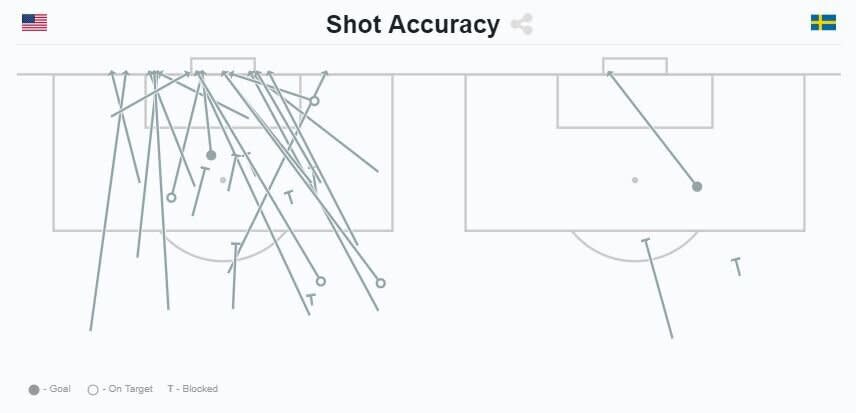How the USWNT's biggest loss in recent memory exposed an issue it still hasn't solved
The U.S. women's national team has been unpredictable over the past three years. From game to game, or even within the same game, there's consistently been a surprise from coach Jill Ellis designed to add more firepower in the attack.
There were the times Ellis had the team play with just three defenders to add an extra number going forward. There were asks for offensive players to fill defensive positions so they could attack, even from the back line. And there have been the late game substitutions where balance goes out the window – just get every attacker possible on the field, even if players are in unusual positions.
Many of these experiments haven't gone particularly well, but Ellis has persisted because the USWNT suffered a trauma in 2016 that she hasn't quite gotten over: losing to Sweden in the Olympics.
At the Rio Games, the USWNT lost to bunkering Sweden team and got knocked out in the quarterfinal round, the USA's earliest exit ever. Up until then, the USWNT had never failed to finish third in a World Cup or an Olympics, and Ellis's mission since then has been to ensure such a disaster never happens again.
But that's been easier said than done, as failed experiments over the past three years have proven, and it's unclear the USWNT has found its answer.

After all, a far inferior South African team bunkered with two blocks of four on Sunday, and the USWNT looked stymied for long stretches. It was a friendly, and the USWNT did eventually win 3-0, but there were many moments where the Americans did not look up to the task of unlocking South Africa's defense.
A better bunkering team could surely still succeed like Sweden did. And given how that loss to Sweden has guided the USWNT's tactics over the past three years – not to mention the fact the two countries will face each other in the final group game at this summer’s World Cup – it's worth revisiting that match.
The first thing to understand about what happened in 2016 is that Sweden's game plan was not a surprise to Ellis or her team.
"They will park the bus," Ellis said the day before the game. "They will sit as low as they possibly can and then look to transition, and they’re going to try to kill the game off that way and not give up space. I imagine they’ll play a 4-5-1 and be very compact.”
That's exactly what Sweden did, and yet the USWNT still couldn’t take a lead at any point. The score ended in a 1-1 draw after 120 minutes, and the U.S. lost in penalty kicks.
But the Americans’ performance in Brasília has been colored – tainted, even – by the fact that they ultimately lost. In truth, they found plenty of chances and were simply unlucky to not put more of them away. If the U.S. had won the penalty kick shootout, the Sweden match would've been a forgettable affair.
Here is each team's shooting map from the game:

The USWNT took 26 shots and only got five of them on target – a problem of execution rather than opportunity. Of those 26 shots, 16 were taken inside the penalty box.
The Americans also dominated the game in other ways. They held onto 64 percent of the possession and controlled the rhythm of the game. They won 65 duels to Sweden's 38, and won 17 tackles to Sweden nine.
Carli Lloyd even scored what should've been the game-winner in the 115th minute of extra time, but she was incorrectly called offside.
In other words, the USWNT's attack wasn't the biggest problem on that day. Sweden did successfully cram the penalty box, and it made it harder for the U.S. to get the shots they wanted. The U.S. also did play a bit too directly and focused on crossing the ball more than working it into dangerous areas with combination play, which led to some low-quality chances. But there were good chances, too.
The reason Sweden won in 2016 was partly because of the USWNT's attacking-first approach. The defenders were flung so far forward in an effort to overload the midfield that it took Sweden two quick passes to bypass the entire defense. It was a textbook absorb-and-counter play, and the USWNT left itself vulnerable because it was so focused on barraging Sweden.
Ellis's takeaway, however, has been the opposite – she apparently decided the USWNT attack didn't do enough against Sweden and more firepower is needed to break a bunker.
In the book, "The National Team: The Inside Story Of The Women Who Changed Soccer," Hope Solo recounts how the day after the loss to Sweden, Ellis spoke with her about the U.S. needing to learn to get past bunkering teams. Solo was later kicked off the team for calling Sweden "a bunch of cowards" for their ultra-defensive strategy, but up until Solo's punishment overshadowed the loss, the talking point from the game was how Sweden successfully bunkered past the No. 1-ranked team in the world.
That's why after the Olympics in late 2016, Ellis concocted a three-back system that would remove one defender and replace her with an attacker.

The experiment was a disaster. The way the USWNT got beat on the counterattack by Sweden became even easier. Romania, a team that has never even qualified for a World Cup, scored a goal that looked beat-for-beat similar to Sweden's goal in the Olympics.
Ellis abandoned the three-back but has been tinkering with other ways to give the USWNT more numbers in the final third.
That's why she has tested out some ultra-attacking rotations, such as putting Tobin Heath, one of the best wingers in the world, is in the central midfield. Mallory Pugh, another winger, started some games in the central midfield during the SheBelieves Cup. Pugh brought almost no defensive presence, but Ellis said she wanted Pugh there to race behind back lines.
The USWNT is as aggressive as it's ever been, and it's because of how Ellis has responded to that loss at the Rio Games three years ago. The team's fullbacks are converted forwards who bomb up the field. The center of the pitch doesn't have a stay-at-home holding midfielder as Julie Ertz is encouraged to fly forward and join the attack.
The Americans undoubtedly are going to score goals in France – that's what they’re built for. The question is how much they will concede in the process.
After all, despite everything that Ellis has tried, one simple soccer truth remains: bunkering often works. That's especially true when the defending team can be quick on the counterattack.
Ellis has to hope that teams in France don't use the Americans' attacking style against them. That's what Sweden did, and becoming an even more attacking U.S. side hasn't solved it.
Caitlin Murray is a contributor to Yahoo Sports and her book about the U.S. women’s national team, The National Team: The Inside Story of the Women Who Changed Soccer, is out now. Follow her on Twitter @caitlinmurr.
More from Yahoo Sports:

